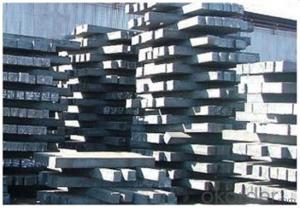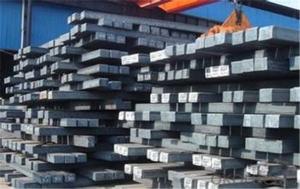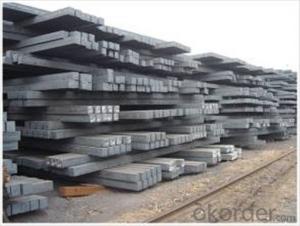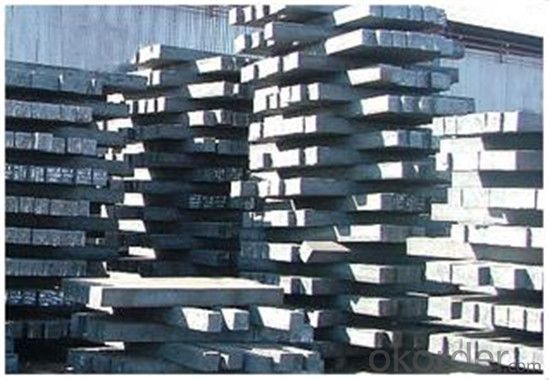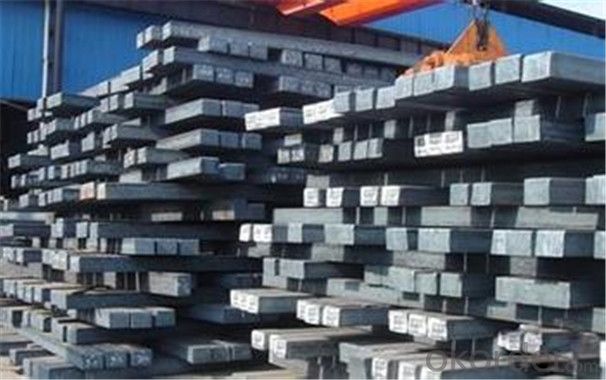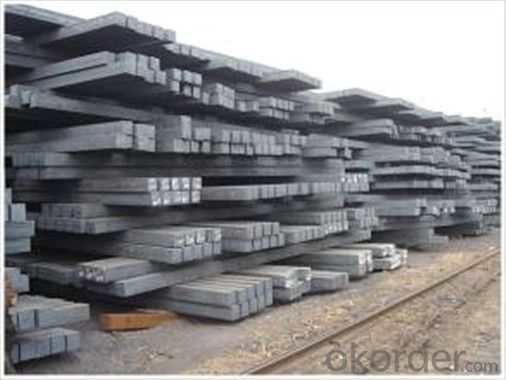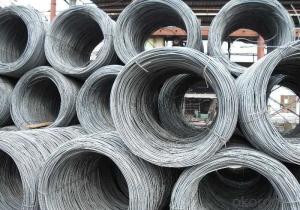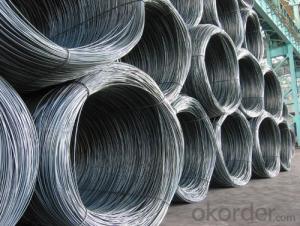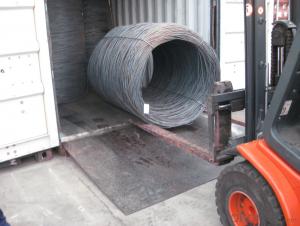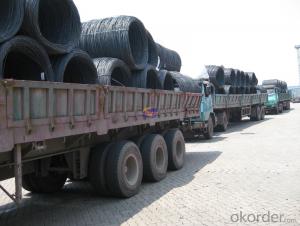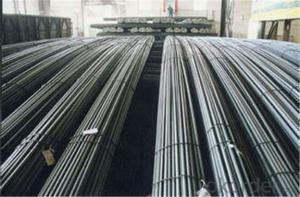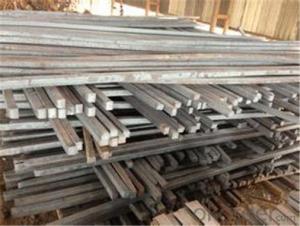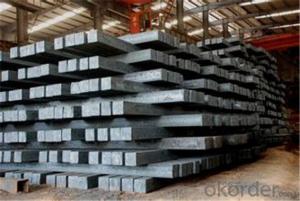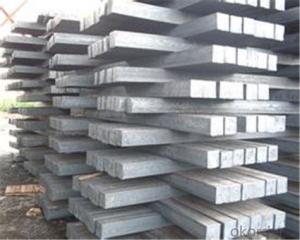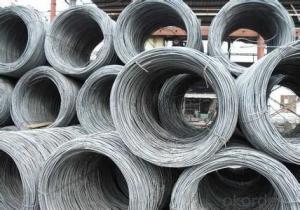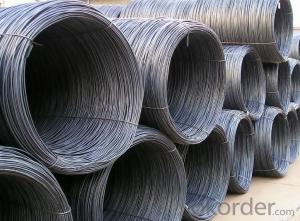Square Steel Billet Hot Sale Q275/5SP in China
- Loading Port:
- Tianjin
- Payment Terms:
- TT OR LC
- Min Order Qty:
- 500 m.t.
- Supply Capability:
- 45555555 m.t./month
OKorder Service Pledge
OKorder Financial Service
You Might Also Like
Specification
Description of steel billet:
Our company is recognized by ISO9001:2008
1. hot rolled wire rod
2. material: Q195-235
Festures of steel billet:
1. Drawn wire specialist, your wire rod solution
2. ISO9001 Certified Mill &SGS
3. Feature: machinability, high hardness, toughness, corrosion resistant
Specifications of steel billet:
Name: | steel billets |
LENGTH: | 6 meter to 12 meter (+ 50mm) |
Size: | 100*100, 120*120, 150*150, 200*200 |
Grade: | 3SP,5SP,Q235,20MnSi. |
Shape: | Square, Round |
Technique: | Hot-Rolled |
Standard: | ASTM/GB |
BENDING | No more than 5mm in 1 meter |
ANGULAR TWIST | No more than 1 degree per meter and not more than 6 degree over 12 meter length. |
Images of steel billet:
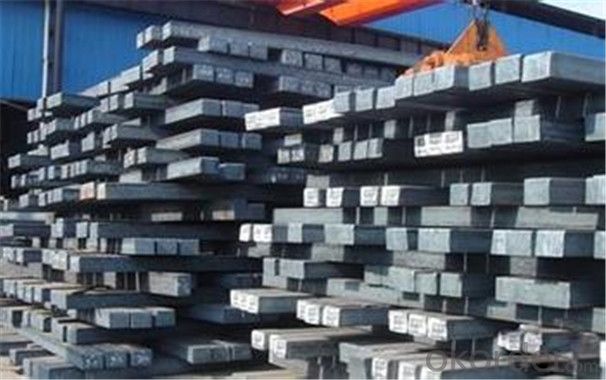
FAQ:
1. What is your package?
Packing situation: standard seaworthy packing or as customer required.
2. How long is the lead time?
Delivery time: 45 days after order confirmed.
3. What payment term do you accept?
Payment: T/T or L/C at sight.
- Q: What are the common production processes for meitnerium-coated steel wire rod?
- The common production processes for meitnerium-coated steel wire rod include cleaning the steel wire rod, applying a layer of meitnerium coating through physical vapor deposition or electroplating methods, and then subjecting the coated wire rod to curing or annealing processes to ensure proper adhesion and durability of the coating.
- Q: What are the different surface coatings available for steel wire rod?
- There are several different surface coatings available for steel wire rods, including zinc coating, galvanized coating, phosphate coating, and epoxy coating. Each coating offers unique benefits such as corrosion resistance, improved adhesion, and increased durability, depending on the specific application and environment in which the wire rod will be used.
- Q: What are the common production processes for xenon-coated steel wire rod?
- The common production processes for xenon-coated steel wire rod typically involve cleaning and pre-treating the steel wire rod, followed by applying a xenon coating using various methods such as physical vapor deposition or chemical vapor deposition. The coated wire rod is then subjected to curing or annealing processes to enhance the adhesion and durability of the xenon coating. Finally, the wire rod is further processed into desired shapes or sizes for specific applications.
- Q: What are the different heat treatment processes used for steel wire rod?
- There are several different heat treatment processes commonly used for steel wire rod to improve its mechanical properties and overall performance. These processes include annealing, quenching and tempering, normalizing, and stress relieving. Annealing is a heat treatment process that involves heating the steel wire rod to a specific temperature and then slowly cooling it to room temperature. This process helps to reduce the hardness and brittleness of the wire rod, making it more ductile and easier to work with. Annealing also helps to remove any internal stresses or strains that may have developed during the manufacturing process. Quenching and tempering is a two-step heat treatment process that involves first heating the steel wire rod to a high temperature and then rapidly cooling it in a quenching medium such as oil or water. This rapid cooling process, known as quenching, hardens the wire rod by forming martensite, a hard and brittle phase. However, this hardened wire rod is also very brittle and prone to cracking. To improve its toughness and ductility, the wire rod is then tempered by reheating it to a lower temperature. This tempering process helps to relieve some of the internal stresses and allows the formation of tempered martensite, which is stronger and more ductile than martensite, but less brittle. Normalizing is another heat treatment process that involves heating the steel wire rod to a temperature slightly above its critical temperature and then allowing it to cool in still air. This process helps to refine the grain structure of the wire rod, making it more uniform and improving its strength and toughness. Normalizing also helps to reduce any internal stresses or strains in the wire rod, improving its dimensional stability and reducing the risk of distortion during further processing. Stress relieving is a heat treatment process that is typically performed after other forming or machining processes have been completed on the steel wire rod. It involves heating the wire rod to a specific temperature below its critical temperature and then slowly cooling it. This process helps to relieve any residual stresses that may have developed during the previous processes, reducing the risk of distortion or cracking in the wire rod. Overall, these different heat treatment processes for steel wire rod provide various benefits such as improved strength, ductility, toughness, and dimensional stability. The specific heat treatment process chosen depends on the desired mechanical properties and performance requirements for the wire rod in its intended application.
- Q: What are the main factors affecting the quality of steel wire rod?
- The main factors affecting the quality of steel wire rod include the choice of raw materials, the manufacturing process, and the use of proper heat treatment techniques. The composition and cleanliness of the raw materials used, such as iron ore and scrap metal, greatly influence the final quality of the steel wire rod. Additionally, the manufacturing process, including the use of advanced technologies and quality control measures, plays a crucial role in ensuring the desired characteristics of the wire rod. Lastly, proper heat treatment techniques, such as annealing or quenching, significantly impact the mechanical properties and overall quality of the steel wire rod.
- Q: How is steel wire rod used in the production of wire mesh for automotive filters?
- Steel wire rod is crucial in making wire mesh for automotive filters. It is processed in a steel mill, where it is heated and rolled into thin wires of the same thickness. This ensures that the wire is strong and flexible, making it suitable for use in different automotive applications. Once the wire rod is turned into wires, it goes through additional processing to create the wire mesh. This involves weaving the wires together in a specific pattern using a specialized machine. The weaving process forms a mesh structure that allows air or fluids to pass through while filtering out impurities. The wire mesh made from steel wire rod is then cut and shaped to fit the specific needs of automotive filters. It is commonly used in air filters, oil filters, and fuel filters, among others. The wire mesh provides a sturdy framework that effectively captures and retains contaminants, preventing them from entering the engine or other crucial systems. Additionally, the use of steel wire rod ensures that the wire mesh can withstand corrosion, high temperatures, and mechanical stress, which are common challenges in automotive applications. This makes it an ideal choice for automotive filters, as they operate in harsh and demanding conditions. In conclusion, steel wire rod is essential for producing wire mesh for automotive filters. It serves as the raw material, offering strength, flexibility, and durability. The wire mesh, in turn, efficiently filters out impurities and protects the integrity of automotive systems.
- Q: What are the different types of steel wire rod finishes?
- There are various finishes for steel wire rods, each with its own purpose and characteristics. Some commonly used finishes are: 1. Black finish: This is a simple, untreated finish that gives the steel wire rod a dark, black color. It offers minimal protection against corrosion and is commonly used in non-structural applications where appearance is not important. 2. Galvanized finish: This finish involves applying a layer of zinc to the steel wire rod to protect it from corrosion. The zinc coating provides excellent resistance to rust and is often used in outdoor or moisture-exposed applications. 3. Coated finish: Steel wire rods can be coated with different materials, such as PVC or nylon, to enhance their resistance to corrosion and abrasion. These coatings can also improve electrical insulation or provide better grip for specific purposes. 4. Stainless steel finish: Stainless steel wire rods are made from an alloy containing a high percentage of chromium, which gives them excellent corrosion resistance. This finish is commonly used in industries like food or medicine, where cleanliness, durability, and resistance to corrosion are important. 5. Bright finish: This finish involves a mechanical or chemical process that removes impurities and oxidation from the surface of the steel wire rod, leaving it smooth and shiny. Bright finishes are often used for decorative purposes or when a visually appealing appearance is desired. 6. Phosphated finish: Phosphating is a chemical process that creates a layer of phosphate coating on the surface of the steel wire rod. This finish enhances corrosion resistance and improves adhesion for painting or further coating, making it suitable for applications requiring such treatments. These examples represent just a few of the available finishes for steel wire rods. The choice of finish depends on the specific requirements of the application, such as corrosion resistance, appearance, or functional properties needed.
- Q: How are steel wire rods used in the production of wire cables for transmitting signals?
- Steel wire rods are essential components in the production of wire cables used for transmitting signals. These rods are initially manufactured by hot rolling billets of low carbon steel into long, thin shapes. This process ensures that the steel wire rods have the necessary strength and flexibility required for their application in wire cable production. Once the steel wire rods are obtained, they undergo various steps to transform them into wire cables capable of transmitting signals. The first step involves cleaning and coating the rods to prevent corrosion and improve their durability. This coating can be made of zinc, copper, or other materials depending on the specific requirements of the cable. After the rods are coated, they are then drawn through a series of dies to decrease their diameter and increase their length. This drawing process further enhances the strength and flexibility of the rods, making them suitable for the demanding conditions that wire cables may encounter during installation and use. The drawn steel wire rods are then twisted or braided together to form the core of the wire cable. This core provides the necessary mechanical strength and stability for the cable, allowing it to withstand tension and external forces. The number of rods used in the core can vary depending on the desired strength and thickness of the cable. To ensure efficient signal transmission, the core is covered with an insulating material, typically made of plastic or rubber. This insulation protects the core from damage, prevents electrical interference, and maintains the integrity of the signal being transmitted. Finally, the completed wire cables are tested to ensure their quality and performance. They are inspected for any defects or imperfections that could affect their ability to transmit signals effectively. Once approved, these cables are ready to be used in various applications, such as telecommunications, electrical systems, and data transmission. In summary, steel wire rods play a crucial role in the production of wire cables used for transmitting signals. They provide the necessary strength, flexibility, and durability to withstand the demanding conditions that wire cables may encounter. Through a series of processes, these rods are transformed into wire cables capable of efficiently transmitting signals while maintaining their mechanical integrity.
- Q: What are the different surface finishes available for steel wire rods?
- There are several different surface finishes available for steel wire rods, each offering unique properties and benefits. Some of the common surface finishes include: 1. Black Oxide Finish: This finish is achieved by applying a chemical treatment to the surface of the steel wire rod, resulting in a black-colored oxide layer. It provides increased corrosion resistance and improved lubricity. 2. Galvanized Finish: In this process, the steel wire rod is coated with a layer of zinc, which provides excellent corrosion resistance. Galvanized wire rods are commonly used in outdoor applications or environments with high humidity. 3. Electroplated Finish: This finish involves applying a thin layer of metal, such as nickel or chromium, to the surface of the steel wire rod through an electroplating process. It enhances the appearance, corrosion resistance, and durability of the wire rod. 4. Powder Coated Finish: Powder coating involves applying a dry powder to the surface of the steel wire rod and then heating it to form a protective and decorative layer. This finish provides excellent resistance to chipping, scratching, and corrosion. 5. Phosphated Finish: Phosphating is a chemical process that forms a layer of phosphate crystals on the surface of the steel wire rod. It improves the adhesion of subsequent coatings, enhances corrosion resistance, and promotes better lubrication. 6. Bare or Natural Finish: In this case, the steel wire rod is left untreated, with no additional coatings or finishes applied. It is typically used in applications where aesthetics are not a concern, and the primary focus is on strength and durability. The choice of surface finish for steel wire rods depends on the specific application requirements, such as corrosion resistance, appearance, lubrication, and environmental conditions.
- Q: How is the price of recycled steel wire rod determined?
- The price of recycled steel wire rod is determined through various factors such as the demand and supply dynamics in the market, the quality and grade of the recycled steel, the costs involved in the recycling process, and the prevailing market conditions. Additionally, factors such as global steel prices, raw material costs, and government policies also influence the price of recycled steel wire rod.
Send your message to us
Square Steel Billet Hot Sale Q275/5SP in China
- Loading Port:
- Tianjin
- Payment Terms:
- TT OR LC
- Min Order Qty:
- 500 m.t.
- Supply Capability:
- 45555555 m.t./month
OKorder Service Pledge
OKorder Financial Service
Similar products
Hot products
Hot Searches
Related keywords
